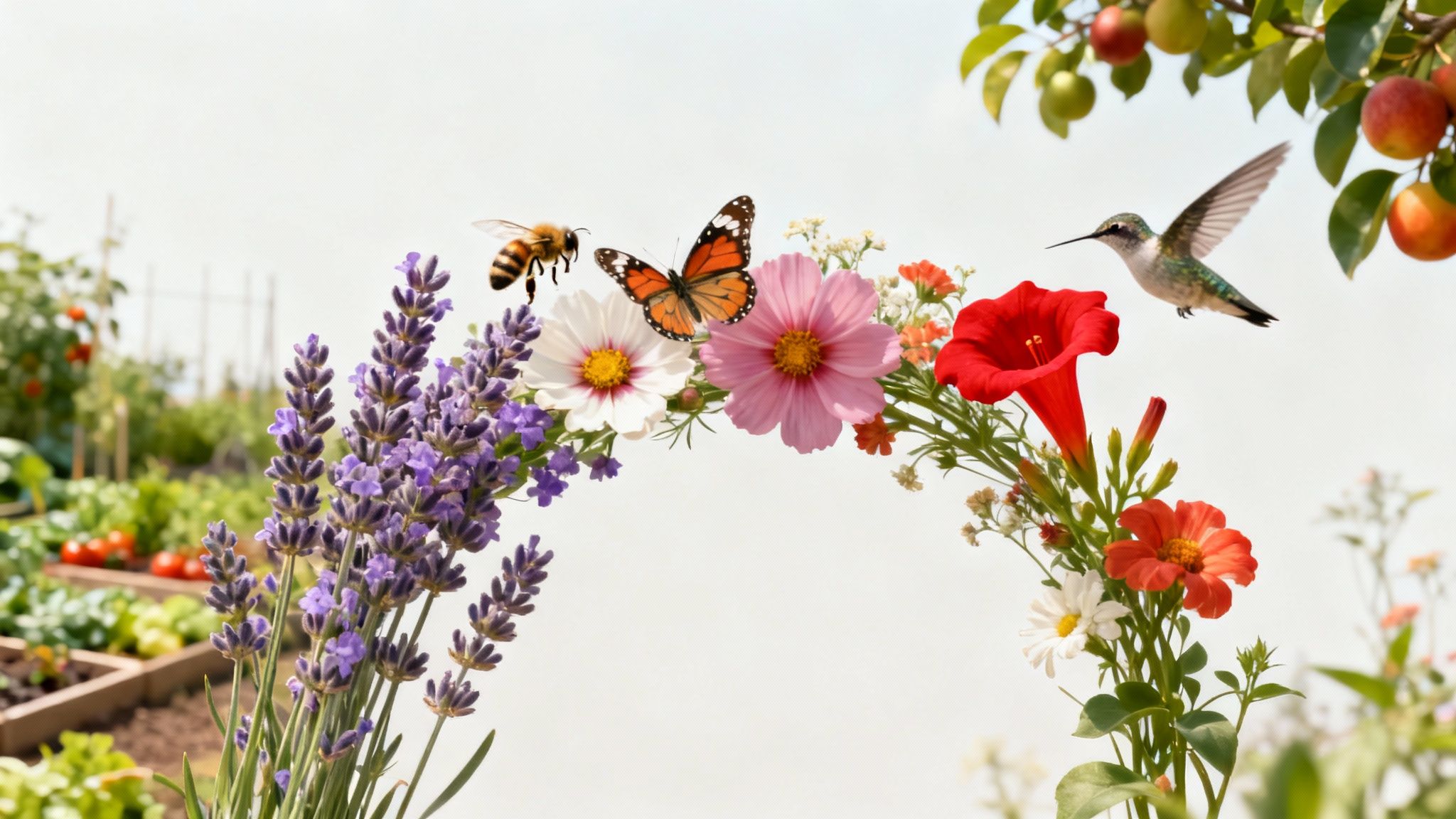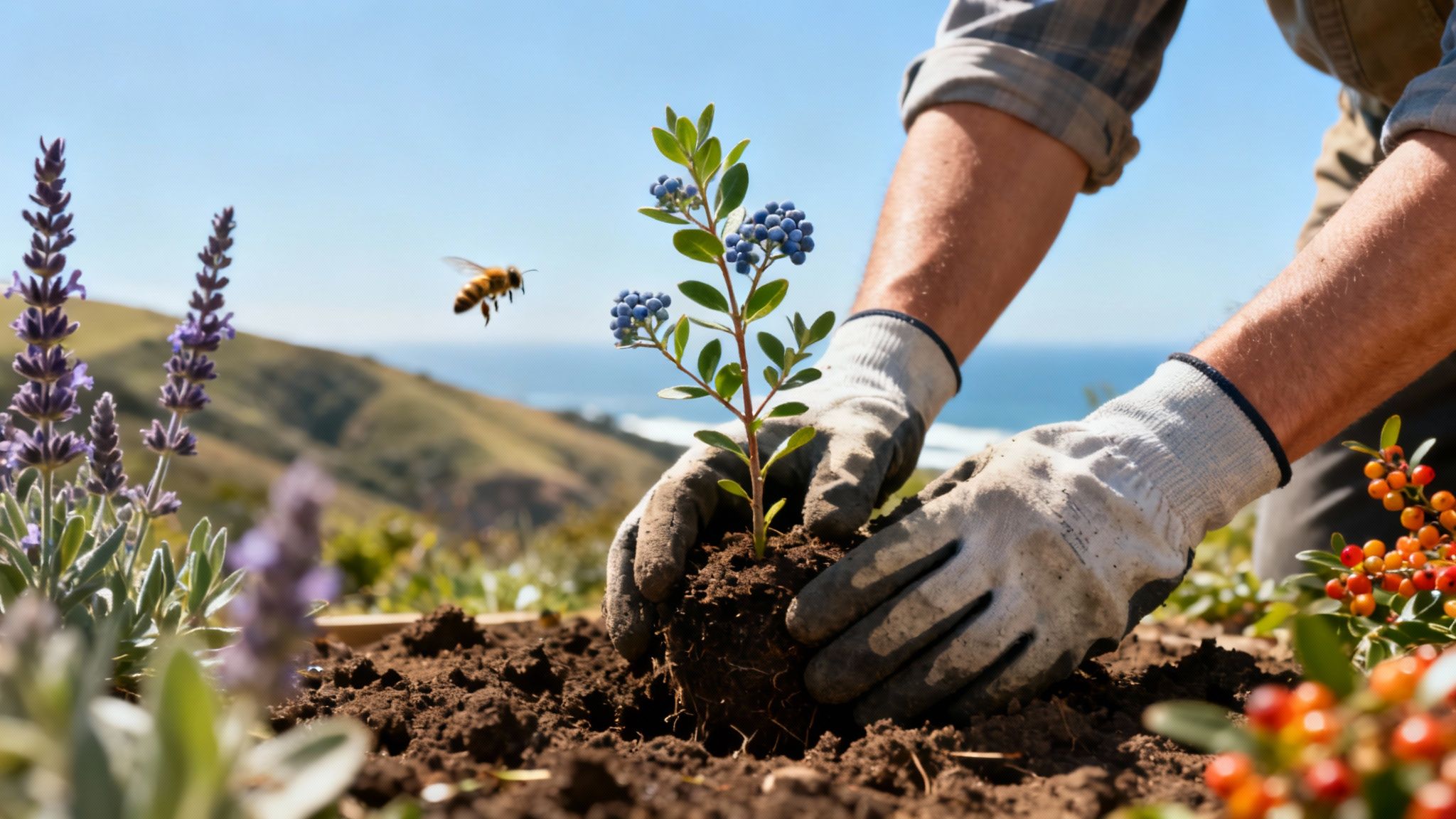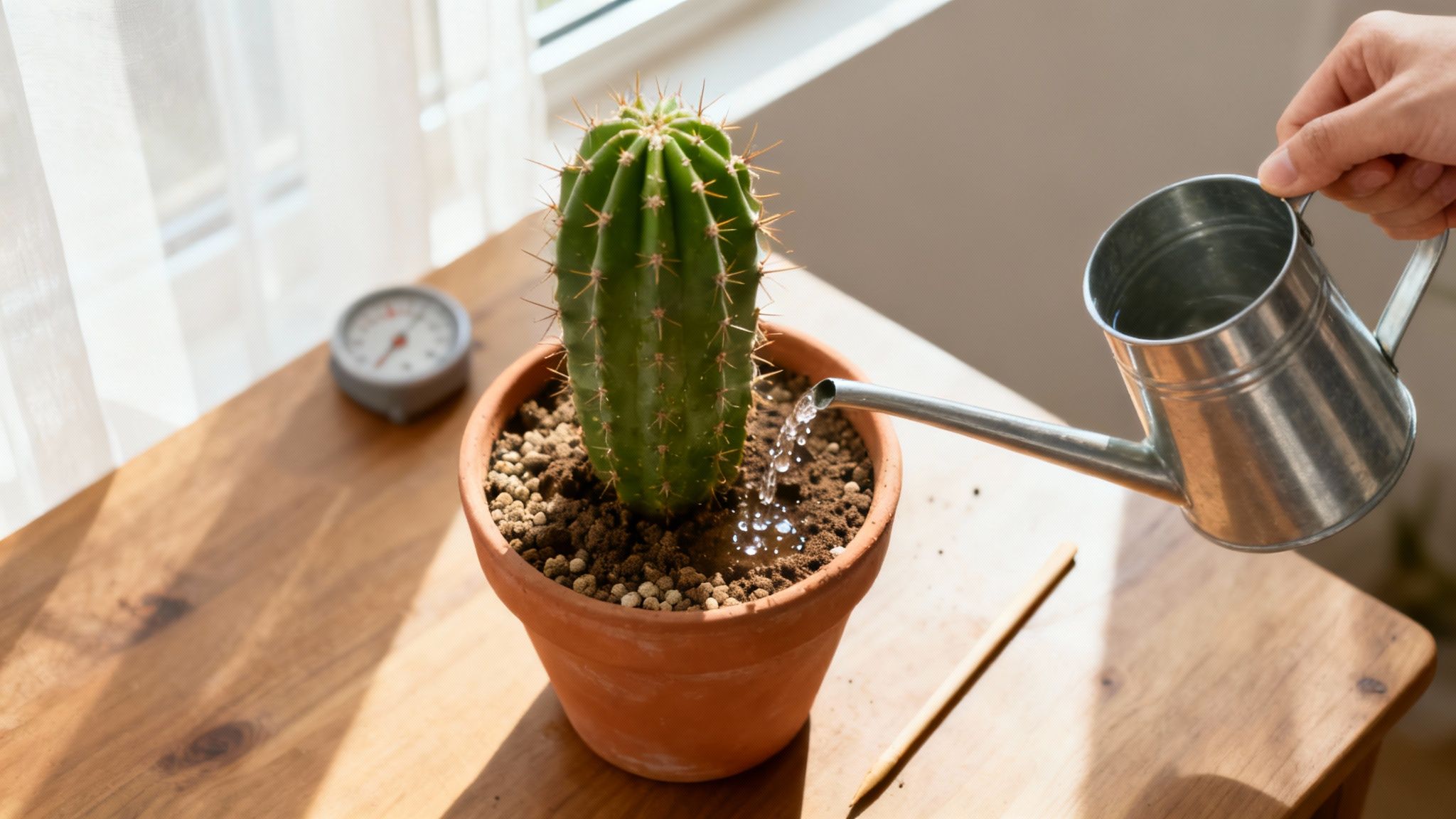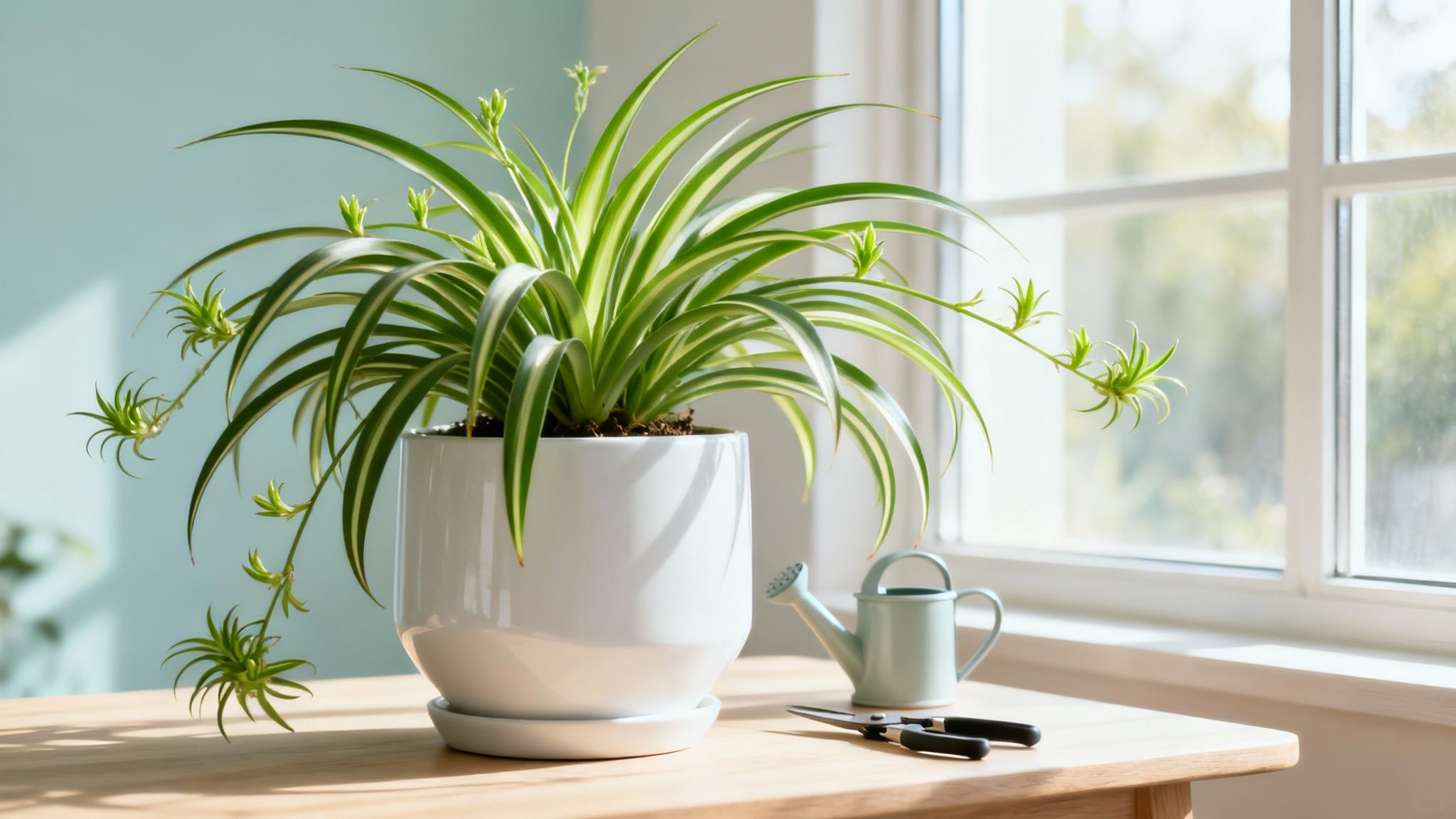Have you ever looked at your fruit trees or vegetable patch, puzzled by the lack of yield despite your best efforts? You've perfected the watering, nailed the feeding schedule, but the results are disappointing. The missing piece of the puzzle often isn't in the soil—it's buzzing in the air around you. We're talking about pollinators, the unsung heroes responsible for turning your beautiful blossoms into a bountiful harvest. Without them, our gardens would be full of flowers but precious little food.
This guide will show you how to partner with these essential garden allies. We’ll explore who these crucial pollinators are, why they're vital for your fruit and vegetable production, and share practical, actionable tips to transform your garden into a welcoming haven they'll flock to. You'll learn how to create a thriving ecosystem that works for you, ensuring a more abundant and flavorful harvest.
Your Garden's Unseen Workforce
Think of your garden as a bustling marketplace. The flowers are the storefronts, but for them to produce goods—like sweet tomatoes (Solanum lycopersicum) or creamy avocados (Persea americana)—they require a specialized delivery service. This is where your garden's unseen workforce, the pollinators, comes in. They are the couriers of the natural world, performing a job that is absolutely essential for about one-third of the food we eat.
Pollination is the simple act of moving pollen from one part of a flower to another, or from one flower to a different one. This fertilizes the plant, kicking off the process that creates the fruits and seeds you want. Without this critical service, countless plants we depend on for food simply couldn't reproduce, and our harvests would fail.
More Than Just Honey Bees
When you hear "pollinator," the European honey bee (Apis mellifera) is likely the first insect that comes to mind. While they are agricultural powerhouses, they're only one member of a much larger, more diverse team. Your garden is visited by a spectacular crew of native specialists who are often even more efficient.
These local heroes include:
Native Bees: From fuzzy bumblebees to tiny, metallic green sweat bees, North America is home to over 4,000 native bee species. Many are solitary, non-aggressive, and far better at pollinating specific native plants and crops than honey bees are.
Butterflies and Moths: As these delicate insects forage for nectar, they inadvertently transfer pollen. Moths take over the night shift, visiting fragrant, night-blooming flowers like evening primrose (Oenothera biennis).
Hummingbirds: These energetic birds are drawn to bright, tubular flowers. They use their long beaks to reach deep for nectar, getting dusted with pollen on their heads and feathers in the process.
Beetles and Flies: Often overlooked, these ancient pollinators are responsible for pollinating some of the world's oldest plant species, like magnolias and spicebush.
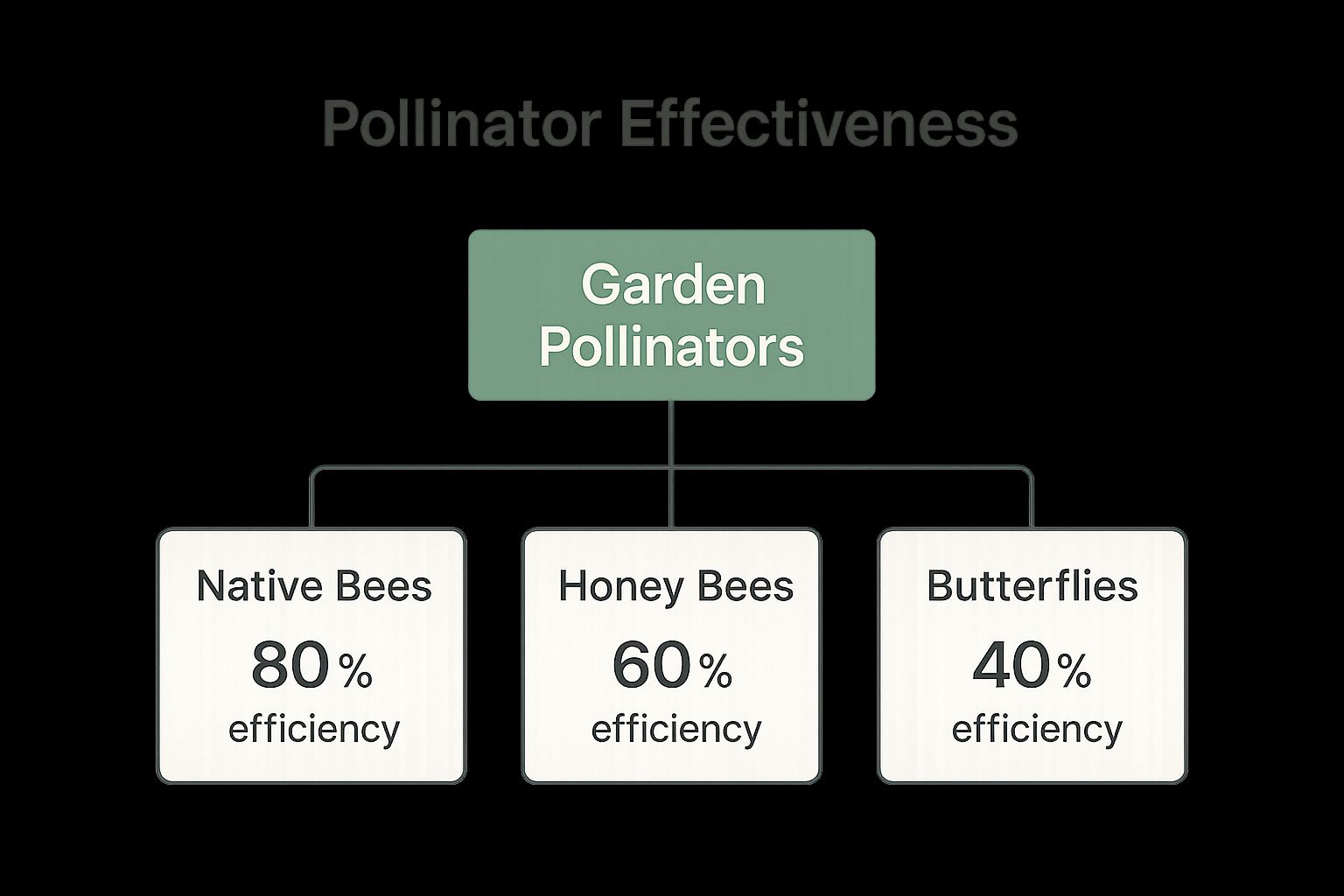
As you can see, native bees are often the most effective workers in a garden ecosystem, making them incredibly valuable allies for any home gardener.
The Critical Link to Your Harvest
The connection between a healthy pollinator population and a bountiful harvest is direct and powerful. Good pollination doesn't just mean more fruit; it often means better fruit. Flowers that are well-pollinated produce fruit that is larger, more symmetrical, and packed with flavor.
For many popular garden plants, cross-pollination—the transfer of pollen between two different plants of the same species—is essential. This is where a diverse team of pollinators becomes a game-changer. Certain bees might prefer your apple blossoms, while butterflies flock to your zucchini flowers. A varied workforce ensures every plant gets the attention it needs.
Surprising Fact: Over 75% of the world’s flowering plants and about 35% of the world's food crops depend on animal pollinators to produce. That includes everything from blueberries to coffee.
Unfortunately, this critical workforce is facing serious challenges. Habitat loss, climate change, and the overuse of pesticides are causing alarming declines in pollinator populations worldwide. Recent studies paint a sobering picture: you can read the full research about these crucial findings to understand the scope of the problem. But as a gardener, you are in a unique position to make a real difference by turning your yard into a vital sanctuary.
How to Create a Pollinator Paradise in Your Garden
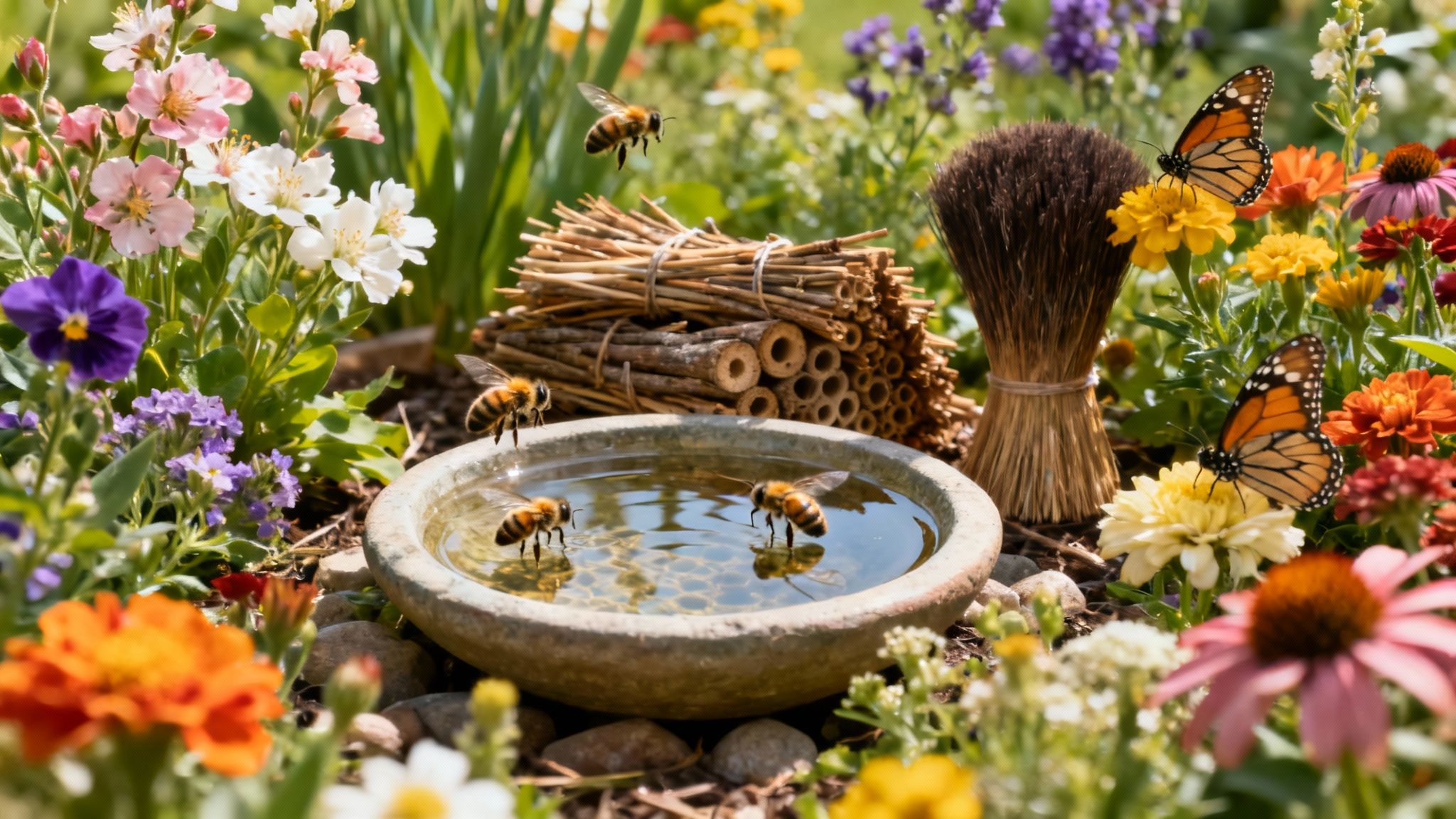
Now for the fun part: rolling out the welcome mat and turning your garden into a place these essential creatures can't resist. It’s easier than you might think and comes down to providing three simple things: food, water, and shelter. Think of it as building a five-star resort for your tiny garden guests.
Plant a Buffet That Never Closes
The single most effective thing you can do for pollinators is to offer a consistent, diverse food source. A garden that only blooms for a few weeks in summer is like a restaurant that’s only open for an hour a day. Your goal is to create a floral buffet that stretches from early spring to late fall.
Here’s a simple guide to planning your seasonal menu:
Early Spring: Kick things off with crocuses (Crocus vernus), lungwort (Pulmonaria officinalis), and willows (Salix spp.) to support the first pollinators emerging from dormancy.
Mid-Summer: This is peak season! Go all out with bee balm (Monarda fistulosa), vibrant coneflowers (Echinacea purpurea), and fragrant lavender (Lavandula angustifolia).
Late Fall: Keep the buffet open with asters (Symphyotrichum ericoides), goldenrod (Solidago), and sedum (Hylotelephium spectabile) to help pollinators fuel up for winter.
Trying to figure out which plants will thrive in your specific climate and bloom at the right times can be a challenge. This is where Tendra's community and tools become invaluable. For a great starting point, check out our guide on how a plant identification app can transform your growing.
Design with Pollinators in Mind
Just like us, pollinators have preferences. The shape, color, and arrangement of your flowers can make your garden a five-star destination. Hummingbirds love long, red tubular flowers. Bees are attracted to blue, purple, and yellow blooms. Butterflies prefer flat-topped flowers like zinnias (Zinnia elegans) that provide a convenient landing pad.
Practical Tip: Plant in clusters. A large patch of a single flower type is far more noticeable to a foraging bee than scattered, individual plants. It acts like a giant, colorful billboard shouting, "Good food here!"
To help you get started, here's a quick reference table matching pollinators with the plants they love.
Pollinator Type | Preferred Flower Characteristics | Example Plants (Common Name) | Scientific Name |
|---|---|---|---|
Bees | Blue, purple, yellow, or white flowers; shallow or with a landing platform. | Bee Balm, Lavender, Sunflower | Monarda, Lavandula, Helianthus |
Butterflies | Brightly colored (red, purple, pink) flowers; flat-topped clusters for landing. | Butterfly Bush, Zinnia, Coneflower | |
Hummingbirds | Red, orange, or pink tubular flowers; high nectar content. | Trumpet Vine, Cardinal Flower, Salvia | |
Moths | Pale or white flowers that are fragrant at night; often tubular. | Evening Primrose, Moonflower, Tobacco Plant | Oenothera biennis, Ipomoea alba, Nicotiana |
Bats | Large, pale, night-blooming flowers with a strong, fruity scent. | Saguaro Cactus, Organ Pipe Cactus | |
Beetles | White or green bowl-shaped flowers, often with a strong, spicy scent. | Magnolia, Pond Lily |
Provide Water and Shelter
Food is crucial, but pollinators also need safe places to drink, rest, and raise their young.
Problem: Many pollinators, especially bees, can easily drown in deep water like bird baths.
Solution: Create a "bee bath." Fill a shallow dish with pebbles or marbles and add just enough water so the tops of the stones stay dry. This gives them a secure place to land and sip safely.
Shelter is just as important. In fact, over 70% of native bee species nest underground in bare soil. You can easily help them by:
Leaving a small, sunny patch of bare ground.
Creating a small brush pile in a quiet corner of your yard.
Letting old perennial stems stand through the winter.
For those planning to grow fruit, Tendra’s extensive cultivar databases for plants like avocados and figs are an amazing resource. You can explore different varieties and their specific pollination needs, helping you select the perfect pollinator-friendly fruit trees right from the start.
Sustainable Practices for a Thriving Pollinator Garden
Creating a garden that hums with life requires a thoughtful, holistic approach. To truly welcome pollinators, you need to turn your gardening habits into powerful actions that protect them. A sustainable garden is a balanced ecosystem that supports the entire web of life, from soil microbes to the bees in the air.
Ditch the Harmful Pesticides
One of the biggest threats to pollinator populations is the widespread use of chemical pesticides. While intended for pests, these chemicals often have devastating, unintended consequences for beneficial insects—including the very pollinators your garden relies on. Neonicotinoids, a class of systemic insecticides, are particularly harmful as they contaminate pollen and nectar, acting as a neurotoxin to foraging bees and butterflies.
The good news? As a home gardener, you have complete control. By choosing to go pesticide-free, you create a safe haven in a world where such spaces are becoming rare.
Embrace Integrated Pest Management (IPM)
So, what should you do when a pest problem arises? The answer is a smarter strategy called Integrated Pest Management (IPM). It’s about preventing problems first and using chemical controls only as a last resort.
Imagine you see strange spots on your squash leaves. Instead of grabbing a spray, an IPM mindset prompts you to investigate first. What’s the real cause? This is where a tool like Tendra's AI disease diagnosis feature shines. A quick photo can help you identify the problem, often pointing to a simple, non-chemical solution. You might discover it's just powdery mildew, which can often be controlled by improving air circulation. For more on responsible plant care, explore our comprehensive plant care guides.
The core principles of IPM for a pollinator-friendly garden are:
Accurate Identification: Know your enemy before you act.
Encourage Natural Predators: Welcome ladybugs and lacewings by planting things they love, like dill and fennel.
Use Physical Barriers: Row covers can effectively shield young plants from pests.
Promote Plant Health: Healthy plants are naturally more resistant to pests and diseases.
Climate change also poses a major threat, disrupting the delicate timing between when flowers bloom and when their pollinators emerge. You can learn more about the various threats pollinators face to get the full picture. By building a resilient, diverse garden, you’re providing a stable habitat that can better absorb these shocks and offer a critical refuge.
Your Garden: A Vital Piece of the Puzzle
It’s easy to feel like your yard is just an isolated plot. But every garden, no matter its size, can be a vital sanctuary for pollinators and a crucial piece of a much larger ecological puzzle. By choosing the right plants and gardening with nature in mind, you’re not just boosting your own harvest; you're directly contributing to local biodiversity and strengthening our food system. Your actions, woven together with thousands of other gardeners, create essential corridors of safety for these incredible creatures.
Discover how to attract more pollinators with Tendra—where local gardeners connect and thrive. Join thousands of gardeners who are turning their yards into productive, buzzing ecosystems.
Common Questions About Attracting Pollinators
Do I need a huge yard to make a difference?
Absolutely not! Every flowering plant helps. A few containers on a balcony can be a critical refueling stop for pollinators in a city.
If I attract bees, am I more likely to get stung?
It’s a common concern, but mostly unfounded. The vast majority of native bees are solitary and non-aggressive. They are far too busy gathering pollen and nectar to bother with you.
How can I deal with pests without hurting pollinators?
Start with Integrated Pest Management (IPM). The first step is always correct identification. Before reaching for a spray, use a tool like Tendra's AI disease diagnosis to understand the root cause. This helps you choose a targeted, non-toxic solution that keeps your beneficial insects safe.
Ready to put these ideas into action? Explore thousands of plant varieties and connect with local gardeners who have solved the very challenges you're facing. Find your plant's local growing partners with Tendra.
